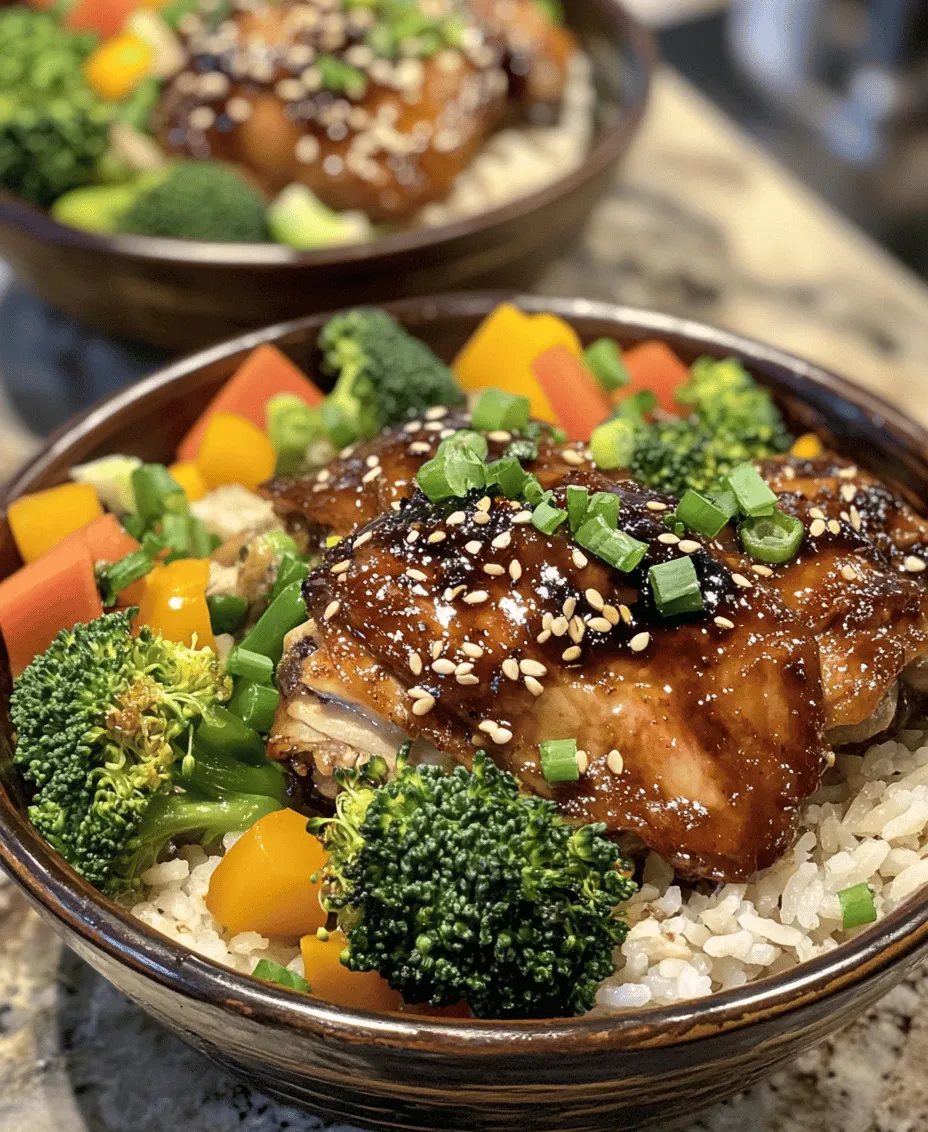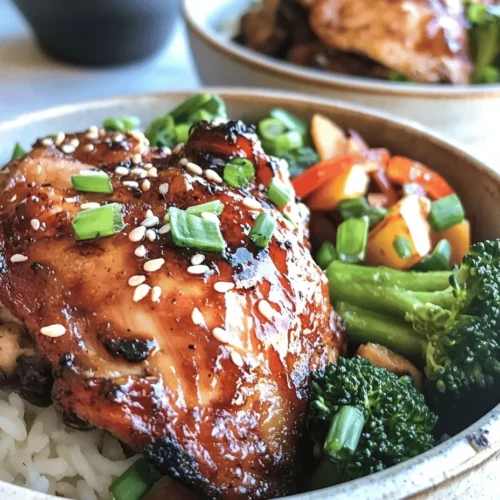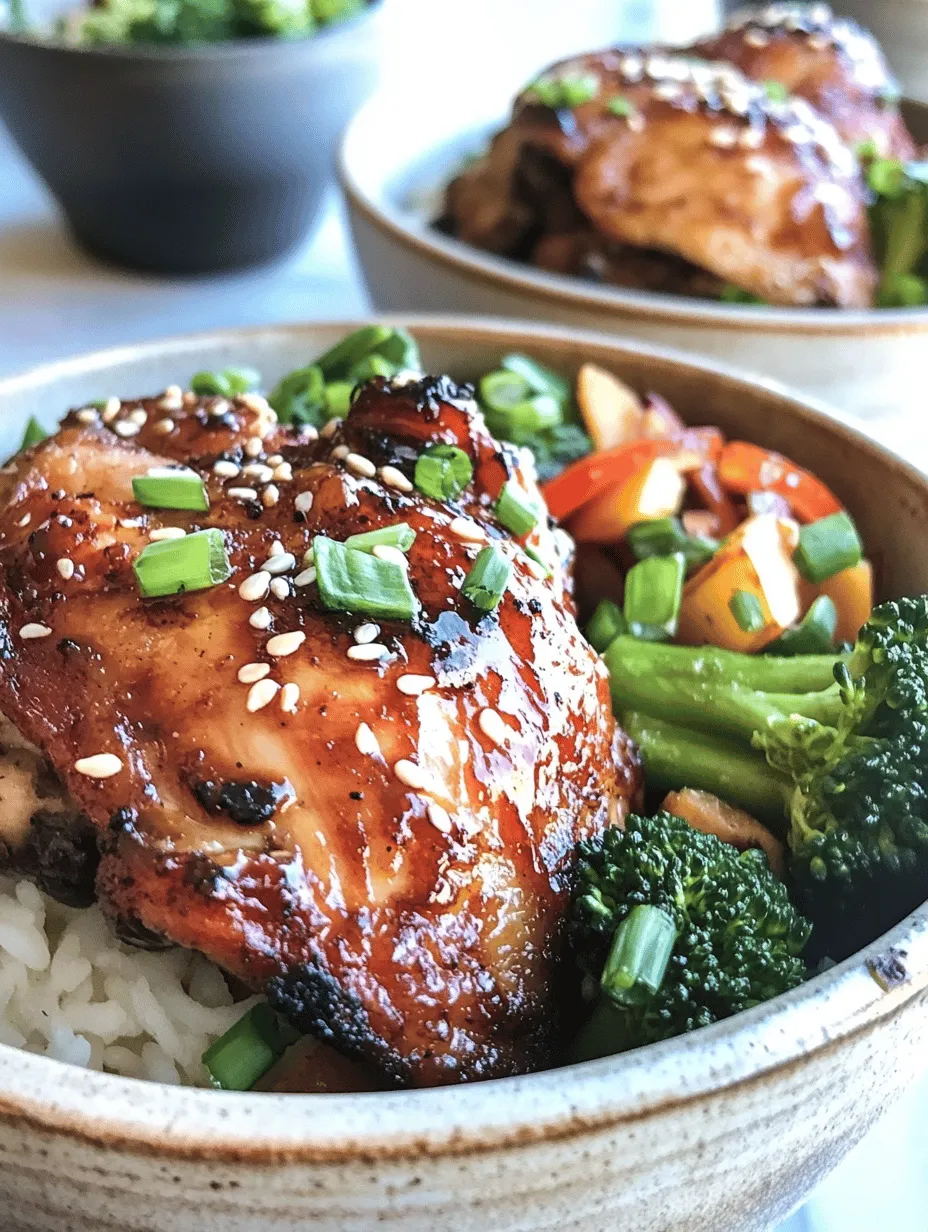Introduction
If you’re on the lookout for a delightful and satisfying meal that brings together rich flavors and comforting textures, look no further than Sticky Chicken Rice Bowls. This dish perfectly marries tender chicken thighs with fluffy jasmine rice, topped off with a savory and sweet sticky sauce that will have your taste buds dancing with joy. The beauty of this recipe lies not only in its delectable taste but also in its simplicity and adaptability, making it ideal for busy families and individuals who crave a homemade meal without spending hours in the kitchen.
In today’s fast-paced world, the importance of home-cooked meals cannot be overstated. Preparing simple yet flavorful dishes like Sticky Chicken Rice Bowls not only nourishes the body but also nourishes the soul. This recipe is a perfect example of how you can create a comforting meal that feels extravagant while using accessible ingredients and straightforward cooking techniques. Whether you’re cooking for a cozy family dinner or meal prepping for the week, this dish delivers on all fronts—flavor, nutrition, and ease.
Understanding the Ingredients
To create the perfect Sticky Chicken Rice Bowls, it’s essential to understand the key ingredients that make this dish shine. Each component contributes to the overall flavor and texture, ensuring that every bite is a delight.
Chicken Thighs
At the heart of this dish are boneless, skinless chicken thighs. While some may opt for chicken breasts, thighs are the superior choice for this recipe. They are juicier and more flavorful than their breast counterparts, thanks to their higher fat content. This makes them less prone to drying out during cooking, which is crucial when you’re aiming for tender, succulent chicken enveloped in a sticky sauce. Additionally, chicken thighs are often more affordable, making them an excellent option for budget-conscious cooks.
Jasmine Rice
Jasmine rice is a staple in many Asian cuisines and is the preferred choice for Sticky Chicken Rice Bowls due to its fragrant aroma and slightly sticky texture when cooked. This long-grain rice is known for its delicate floral notes and soft, fluffy consistency, which pairs perfectly with the sticky marinade of the chicken. The rice acts as a base that absorbs the flavors of the sauce, creating a harmonious balance on your plate.
Chicken Broth
Using chicken broth instead of water to cook the rice elevates the dish’s flavor profile significantly. The broth infuses the rice with a savory depth that plain water simply cannot achieve. It enhances the overall richness of the meal, ensuring that every component is bursting with flavor. Opt for low-sodium broth if you’re watching your salt intake, and feel free to make your own or choose a quality store-bought option.
Soy Sauce, Honey, Rice Vinegar, and Sesame Oil
The sticky marinade that coats the chicken is a harmonious blend of soy sauce, honey, rice vinegar, and sesame oil. Soy sauce brings umami depth and saltiness, while honey adds a natural sweetness that balances the saltiness of the soy. Rice vinegar introduces a touch of acidity, brightening the flavors and cutting through the richness of the chicken. Lastly, a drizzle of sesame oil imparts a nutty aroma and adds an extra layer of complexity to the dish. Together, these ingredients create a sticky glaze that clings beautifully to the chicken, making every bite a burst of flavor.
Garlic and Ginger
No Asian-inspired dish is complete without the aromatic duo of garlic and ginger. Both ingredients play a pivotal role in this recipe, adding warmth and depth to the marinade. Garlic provides a savory punch, while ginger adds a hint of spiciness and freshness. Beyond their flavor contributions, garlic and ginger are also celebrated for their numerous health benefits, including anti-inflammatory properties and digestive support.
Fresh Vegetables
To round out your Sticky Chicken Rice Bowls, incorporating fresh vegetables is essential. Not only do they add vibrant color and crunch, but they also enhance the nutritional value of the dish. Consider using a mix of bell peppers, snap peas, broccoli, or carrots—whatever you have on hand. The vegetables not only provide texture but also a refreshing contrast to the rich, sticky chicken, making each bite more satisfying.
Marinating the Chicken
Marinating the chicken is a crucial step in achieving maximum flavor in your Sticky Chicken Rice Bowls. By allowing the chicken to soak in the marinade, you enable the flavors to penetrate the meat, resulting in a more delicious and aromatic dish.
The Importance of Marination
Marination serves multiple purposes; it not only enhances the flavor but also helps to tenderize the meat. The acids in the marinade, particularly from the rice vinegar and honey, work to break down the protein fibers in the chicken, making it more tender and juicy. This is particularly important for chicken thighs, as it allows them to absorb the marinade’s flavors more effectively.
Suggested Marination Time
For optimal flavor, marinate the chicken for at least 30 minutes. However, if time permits, aim for 2 to 4 hours for best results. If you’re prepping ahead of time, marinating the chicken overnight in the refrigerator will yield even more flavorful results. Just be sure to keep it covered to prevent contamination.
Flavor Profile Contributions
Each ingredient in the marinade contributes to the overall flavor profile of the dish. The soy sauce provides the foundational savory element, while the honey adds a hint of sweetness that balances the saltiness. The rice vinegar’s acidity cuts through the richness, ensuring a well-rounded flavor. Garlic and ginger complete the marinade with their aromatic qualities, creating a deliciously sticky coating that will enhance the chicken during cooking.
Cooking the Rice
Now that your chicken is marinating, it’s time to prepare the jasmine rice. Cooking rice may seem straightforward, but there are specific steps you can take to ensure that your rice turns out perfectly fluffy and flavorful.
Step-by-Step Guide to Cooking Jasmine Rice
1. Rinsing the Rice: Begin by rinsing the jasmine rice under cold water. This step is crucial as it removes excess starch, which can make the rice gummy. Rinsing helps to achieve that light and fluffy texture we all love.
2. Cooking Method: In a saucepan, combine the rinsed rice with chicken broth in a 1:1 ratio. For every cup of rice, use one cup of broth. Bring the mixture to a boil over medium-high heat. Once it reaches a boil, reduce the heat to low, cover the pot, and let it simmer for about 15 minutes.
3. Fluffing the Rice: After 15 minutes, remove the pot from the heat but keep it covered. Let it sit for an additional 10 minutes to allow the rice to steam and finish cooking. Finally, use a fork to fluff the rice gently before serving. This will separate the grains and enhance the texture.
Tips for Achieving Perfect Texture and Fluffiness
– Measure Accurately: Ensure you measure both the rice and broth accurately. Too much liquid can lead to mushy rice, while too little can result in undercooked grains.
– Avoid Over-Stirring: Once you add the rice to the boiling broth, avoid stirring it too much. Excess stirring can release more starch, leading to a sticky texture.
– Let it Rest: Allowing the rice to rest after cooking is key to achieving a fluffy consistency. This resting period lets the steam complete the cooking process without making the rice soggy.
Cooking the Chicken
With the rice cooked and the chicken marinated, it’s time to bring your Sticky Chicken Rice Bowls to life by cooking the chicken thighs to perfection.
Techniques for Cooking Chicken Thighs to Perfection
1. Choose Your Cooking Method: You can either grill, bake, or pan-sear the chicken thighs. Each method has its benefits; grilling imparts a smoky flavor, baking is hands-off, and pan-searing offers a crispy exterior. For this recipe, we recommend pan-searing for a deliciously caramelized crust.
2. Preheat Your Pan: If you choose to pan-sear, heat a tablespoon of oil in a large skillet over medium-high heat. Ensure the oil is hot before adding the chicken to achieve a nice sear.
3. Cook the Chicken: Remove the chicken from the marinade, allowing any excess to drip off. Carefully place the thighs in the hot skillet, ensuring they are not overcrowded. Cook for about 5-7 minutes on each side, or until the internal temperature reaches 165°F (75°C) and the chicken is caramelized on the outside.
4. Baste with Marinade: For added flavor, you can baste the chicken with some of the reserved marinade during the last few minutes of cooking. This step will enhance the sticky quality of the glaze while ensuring the chicken stays moist.
5. Rest the Chicken: Once cooked, allow the chicken to rest for a few minutes before slicing. This resting period helps to retain the juices, resulting in more tender and flavorful meat.
As the chicken cooks, the aroma of the marinade will fill your kitchen, promising a delicious meal ahead. Once everything is ready, you’ll be able to assemble your Sticky Chicken Rice Bowls, layering the fluffy rice, succulent chicken, and vibrant vegetables into a satisfying and visually appealing dish.
Stay tuned for the next part, where we’ll guide you through assembling and serving your Sticky Chicken Rice Bowls, along with some tips to elevate this dish even further!

Recommended Cooking Methods: Skillet vs. Oven
When it comes to preparing Sticky Chicken Rice Bowls, choosing the right cooking method can significantly influence the texture and flavor of the chicken. The two most popular options are skillet cooking and oven roasting.
Skillet Cooking:
Using a skillet allows for a quick and efficient cooking process. The high heat from the skillet gives the chicken a nice sear, locking in juices and creating a delectable caramelized crust. To achieve optimal results, preheat your skillet over medium-high heat and add a little oil. Once the oil is shimmering, add the marinated chicken pieces. Cook for around 6-8 minutes on each side, or until the chicken reaches a golden-brown color and is cooked through.
Oven Roasting:
For those who prefer a hands-off approach, roasting the chicken in the oven is an excellent alternative. Preheat your oven to 400°F (200°C) and place the marinated chicken on a baking sheet lined with parchment paper. Bake for about 25-30 minutes, or until the chicken is fully cooked and the juices run clear. This method allows the flavors to develop fully while requiring less active cooking time.
Importance of Achieving the Right Internal Temperature
Regardless of the cooking method chosen, achieving the correct internal temperature is crucial for ensuring food safety and maximizing flavor. Chicken should always be cooked to an internal temperature of 165°F (75°C). This ensures that any harmful bacteria are eliminated while keeping the chicken juicy and tender.
Tips for Checking Doneness and Ensuring Juiciness
To check for doneness, use a meat thermometer inserted into the thickest part of the chicken, avoiding bones. If you don’t have a thermometer, you can also cut into the chicken to ensure the juices run clear and the meat is no longer pink. Remember, letting the chicken rest for a few minutes after cooking will also help retain its juices, resulting in a more succulent dish.
Assembling the Bowls
Now that the chicken is perfectly cooked, it’s time to assemble your Sticky Chicken Rice Bowls. Presentation is key, and there are numerous creative ways to make your dish visually appealing.
Layering Techniques for Visual Appeal
Start by placing a generous serving of rice at the bottom of your bowl. For added texture and flavor, consider using a mix of jasmine rice and quinoa or brown rice for a nutritious twist. Next, layer on the sliced sticky chicken, arranging it artfully over the rice.
For an extra touch of creativity, you can create additional layers by adding sautéed vegetables such as bell peppers, snap peas, or bok choy. This not only enhances the visual appeal but also adds a variety of colors and textures to your meal.
Suggestions for Additional Toppings or Variations
Don’t hesitate to get creative with your toppings. A sprinkle of toasted sesame seeds adds a delightful crunch, while thinly sliced green onions can provide a fresh, zesty flavor. For those who enjoy a bit of heat, diced jalapeños or a drizzle of sriracha can elevate the dish even further.
You might also consider incorporating a side of pickled vegetables for a tangy contrast to the sweetness of the sticky chicken. This balance of flavors and textures will take your rice bowls to the next level.
Garnishing and Serving Suggestions
When it comes to garnishing your Sticky Chicken Rice Bowls, the right finishing touches can truly enhance the overall presentation.
Ideas for Garnishing to Enhance Presentation
Fresh herbs, such as cilantro or parsley, can bring a pop of color and freshness to your dish. Simply scatter them over the top before serving. Alternatively, a squeeze of lime juice can add brightness and elevate the flavors beautifully.
Role of Green Onions and Sesame Seeds in Flavor and Texture
Green onions are not only visually appealing but also add a mild onion flavor that complements the sweetness of the chicken. Toasted sesame seeds provide a nutty crunch, making them a perfect garnish to enhance both the texture and flavor profile of the bowl.
Suggestions for Complementary Side Dishes or Beverages
To create a well-rounded meal, consider serving your Sticky Chicken Rice Bowls alongside a light cucumber salad or a miso soup. These options will provide a refreshing contrast to the richness of the chicken. As for beverages, a cold glass of iced green tea or a light beer can be the perfect accompaniment.
Nutritional Information
Understanding the nutritional value of your meal is essential, especially when meal planning.
Breakdown of Calories and Nutrients per Serving
A typical serving of Sticky Chicken Rice Bowls (containing about 4 ounces of chicken, 1 cup of rice, and vegetables) can be estimated at approximately 550-600 calories. This includes a balance of protein, carbohydrates, and healthy fats, making it a satisfying meal option.
Health Benefits of the Ingredients Used in the Recipe
The ingredients in this recipe offer numerous health benefits. Chicken is a great source of lean protein, which is essential for muscle growth and repair. The vegetables add fiber, vitamins, and minerals, promoting overall health. Additionally, using brown rice or quinoa increases the fiber content and provides complex carbohydrates that support sustained energy levels.
Discussion on Portion Control and Balanced Meals
While Sticky Chicken Rice Bowls can be a hearty meal, practicing portion control is important. Aim to fill half of your bowl with vegetables, one-fourth with protein, and one-fourth with grains. This approach ensures a balanced meal that supports your nutritional needs.
Variations and Customizations
One of the best things about Sticky Chicken Rice Bowls is their versatility. You can easily customize the recipe to suit your dietary preferences or seasonal availability.
Suggestions for Altering the Recipe to Suit Dietary Preferences
For those who prefer not to eat chicken, consider substituting it with tofu, tempeh, or seitan, which can be marinated in the same sticky sauce for a satisfying alternative.
Vegetarian or Vegan Options: Substitutes for Chicken
To make the dish vegetarian or vegan, use plant-based proteins like marinated and grilled tofu or a chickpea stir-fry. These options will absorb the flavors beautifully and provide a hearty protein source.
Customizing the Vegetables: Seasonal Choices and Personal Preferences
Feel free to switch up the vegetables based on what’s in season or what you prefer. Zucchini, carrots, and broccoli all work wonderfully in this dish. You can also add in leafy greens like spinach or kale for an extra nutritional boost.
Alternative Grains: Options for Those Who Prefer Quinoa or Brown Rice
If you’re looking to switch up the grain base, quinoa is an excellent choice due to its high protein content and nutty flavor. Brown rice provides a chewy texture and additional fiber. Experimenting with different grains can add a delightful twist to your rice bowls.
Conclusion
Sticky Chicken Rice Bowls are not only a delicious option for a weeknight dinner but also a versatile dish that can be tailored to suit various tastes and dietary preferences. With their combination of flavors and textures, they can easily become a staple in your meal planning.
Encouragement to try the recipe is key; cooking at home allows you to control the ingredients and experiment with flavors, which can be a joyful experience. Sharing these homemade meals with loved ones fosters connection and creates lasting memories. So gather your ingredients, unleash your creativity, and enjoy the art of cooking!



